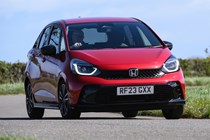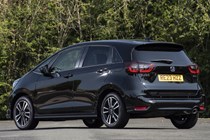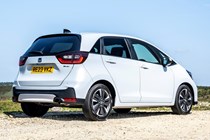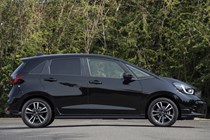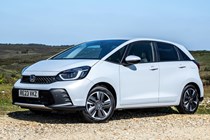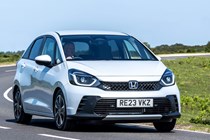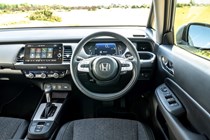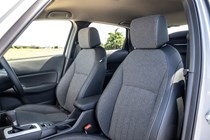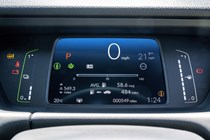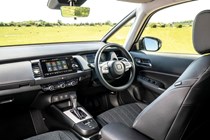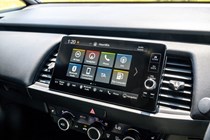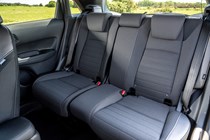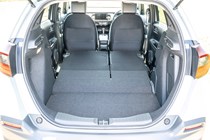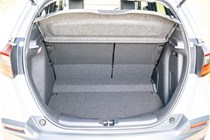
Honda Jazz engines, drive and performance
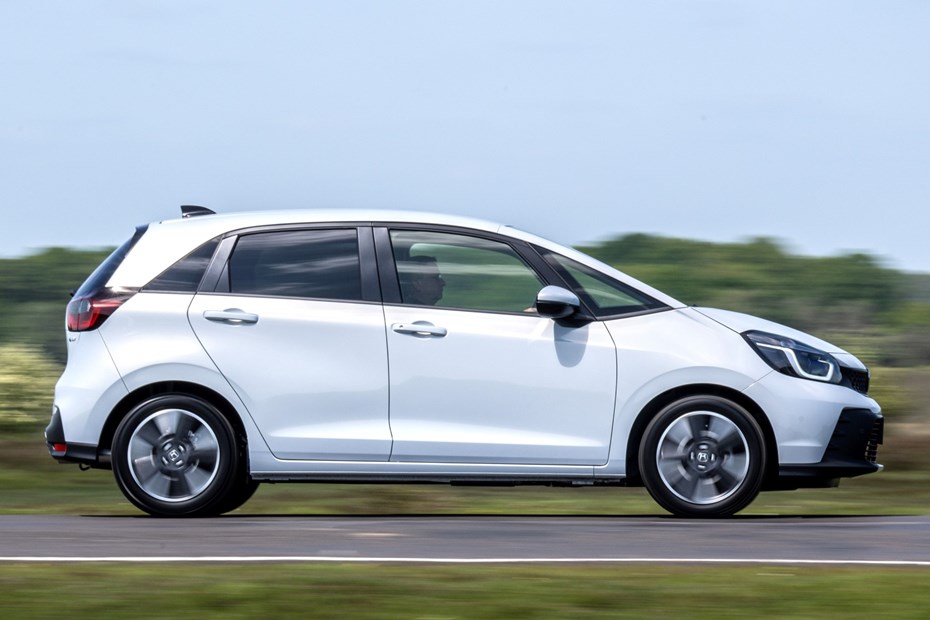
- Hybrid engine only
- Runs like an electric car in town
- Petrol motor boosts performance and range
The Honda Jazz is available exclusively with a clever hybrid system that uses battery power in town, a conventional engine on faster roads, and a mix of the two elsewhere. It uses a 1.5-litre petrol engine, two electric motors and a lithium ion battery to produce 122hp and 253Nm of torque.
The second figure is higher than any previous Jazz and gives the car a suitably muscular feel, especially when pulling away from a standstill – this generation car completes the 0-62mph sprint in 9.4 seconds. Hardly a hot hatch, but brisk enough to deliver reassuring oomph and one of the swifter regular superminis out there.
Honda claims the hybrid Jazz has the best ratio of fuel economy to acceleration of any small hatchback – we’ve examined the former in the running costs section, but as for the latter, we think it feels sprightly around town and more than able to keep up with faster traffic on main roads regardless of its bold mpg claims.
As a result, it’s a very relaxing car to drive – you don’t need to stand on the accelerator pedal or wait for the engine to reach high revs to deliver a decent woosh of power – like a full-EV, there’s a good amount of shove just waiting for a flex of your right foot.

In town at sedate speeds the Jazz runs in silent EV mode – and only when the battery level drops or more power is required does the engine quietly hum away in the background, topping up the charge.
On faster roads a clutch connecting the engine and wheels can close, allowing the petrol engine to deliver direct drive with power boosted from the battery. At this point, the engine speed rises and falls through several simulated gears to make it sound and feel more like a conventional car.
Percy Lawman, senior product content manager at Parkers, recently ran a Jazz for several months as his everyday car, and found particular oddities with the powertrain, saying: “You don’t seem to have any control on the revs as they go ballistically skywards and it’s like being at half throttle but you’re not going anywhere.”
So the Jazz’s hybrid setup is a bit of an oddity, but not as much as the old Jazz Hybrid, which would hold the engine at constant high revs while the speed of the car increased, so that’s a win in our book. A similar system is used in the CR-V Hybrid – expect to see it in many more Hondas soon.
What is the Jazz like to drive?
- Variable ratio steering is fitted
- Suspension tweaks help agility
- A bit of a cornering dark horse
The big headline changes for this generation of Jazz are the inclusion of a variable ratio steering rack, a stiffer understructure and reworked suspension.
What does that all mean? Well, the new steering turns the front wheels progressively further the more you turn the wheel. So a small rotation just off centre has little effect, whereas the same movement with a quarter turn of lock on has a big effect.
This helps makes the car feel stable at speed and more agile when cornering, and it works really well. A variable ratio rack can sometimes feel unpredictable, suddenly speeding up and causing the front end to dive into the corner, but in the Jazz it feels pretty natural. The steering weight is very light – almost alarmingly so at first – but it does mean super-easy manoeuvring in town.
A greater use of high-strength steel in the bodywork means a better platform from which to tune the suspension, so it can offer more precise handling without having to resort to stiff, uncomfortable springs.

As such if you look under the skin of this car you’ll find newly designed front suspension with reduced friction for less vibration, and softened rear springs for greater passenger comfort.
The Jazz is actually quite a fun car to drive as a result – not in the same league as a Ford Fiesta, but eager enough with little bodyroll and good levels of grip. The brakes are strong and there’s also a ‘B’ mode, which slows the car down when you take your foot off the throttle, like in a conventional car.
Finally, a clever system called Agile Handling Assist improves safety and cornering response by applying a small amount of braking force to the wheel closest to the inside corner in order to improve stability and grip.
In most situations this does away with the need for a more intrusive intervention from the traction control system – in other words, the car won’t aggressively cut the engine power when it thinks you’re about to lose grip. Even so, this is a car that’s happier being driven slower, where you’ll be able to appreciate the supple ride that only gets upset on occasion. Its comfort makes it a surprisingly good long-distance companion.


